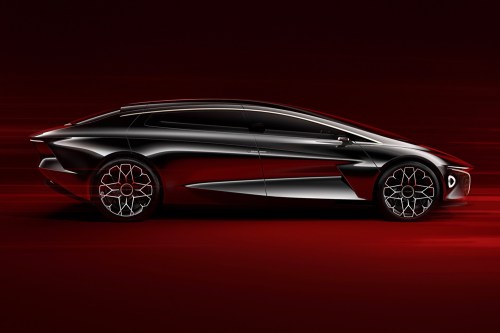
Aston Martin’s new factory in St. Athan, Wales, will become a hub for electric cars, the automaker said in a statement. The factory will build Aston’s first electric car, as well as future luxury electric cars under the Lagonda sub-brand.
The first electric car to roll out of St. Athan will be an electric version of the Rapide four-door. The car was previously referred to as the “RapidE,” but Aston now says the official name will be “Rapide E.” Aston hasn’t released final specifications, but a prototype unveiled in 2015 was said to have between 800 and 1,000 horsepower, and a range of 200 miles. When production starts in 2019, the car will likely be built in limited numbers as a warmup to larger-scale electric-car production.
The Rapide E will be followed in 2021 by the first electric car produced under the Lagonda sub-brand. Lagonda started out as an independent automaker in 1904, and was purchased by Aston Martin savior David Brown in 1947, with Brown merging the two brands. The Lagonda name has since been used sporadically on luxury sedans, most recently in 2014 on the Lagonda Taraf.
At the 2018 Geneva Motor Show, Aston unveiled the Lagonda Vision concept, a futuristic-looking electric limousine, and announced plans to revive the Lagonda name for a line of electric cars. The first Lagonda production model is expected to be a sedan like the Vision concept, followed by an SUV and coupe.
Not everything built at St. Athan will be electric. The factory, which sits on a former British Royal Air Force base, will also build Aston’s first SUV. Aston previewed this model with the DBX concept at the 2015 Geneva Motor Show. While the DBX had an electric powertrain, the production SUV is expected to use internal-combustion power. The Bentley Bentayga, Rolls-Royce Cullinan, and Lamborghini Urus have shown that there is no shortage of interest in high-end SUVs.
SUV production will start alongside the electric Rapide E in 2019. Aston moved into the St. Athan facility last year, celebrating with a donut session involving $83.4 million worth of cars. The automaker said it is still in the process of converting three large hangars into an assembly line ahead of the start of production.
Editors' Recommendations
- Fake engine noises in electric cars need to die
- The cheapest electric cars you can buy
- Pros and cons of buying a used electric car
- VinFast’s new electric cars will be available in the U.S. this year
- VW previews its next electric car in trippy camouflaged form